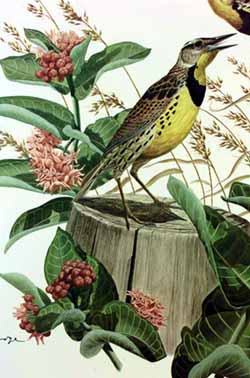
Lithograph, 22 by 28 inches
Reproduced from the original painting by Richard Sloan, who was commissioned by the Griggsville Wild Bird Society to creat a series of state bird paintings.
Copyright J.L. Wade
Illinois State Museum collection
Gift of the Griggsville Wild Bird Society (now known as the Nature Society)
Eastern Meadowlark
(Sturnella magna)
Interesting facts:
The Eastern Meadowlark is not actually a member of the lark family, but is a member of the blackbird family. It gets its name meadowlark because it sings prettily like a lark. It also inhabits open areas as a lark does. The song of the meadowlark sounds like "See-you-see-yer."
Description:
Eastern Meadowlarks are 9 to 11 inches long and have a stocky build. Their yellow breast with a large black "V" on it distinguishes them from any other bird. They have a large pointed bill. Their back and wings are brown streaked with black. The brown tail has white outer feathers.
Habitat and behavior:
Migrating adults arrive in Illinois in March and stay until October or November, flying by day short distances at low altitudes. Eastern Meadowlarks live in grasslands, prairies, hay fields and fallow farm fields, and in row crops. In tall grass they build a cup-like nest of dry grass, horsehair, pine needles, and plant stems. The female lays 2-6 white eggs spotted with reddish-brown. The eggs hatch in about 12 days.
Food:
Eastern Meadowlarks eat insects such as cutworms, caterpillars, beetles, and grasshoppers. In winter they eat seeds and grain.
Status:
The Eastern Meadowlark is a protected short-distance migrant.